Choose the Right Event and Topic
Learning Objectives
After completing this unit, you’ll be able to:
- Identify the right Salesforce-related event for your presentation.
- Create a compelling session title and abstract.
- Write learning objectives for your presentation.
Choose the Right Event for You
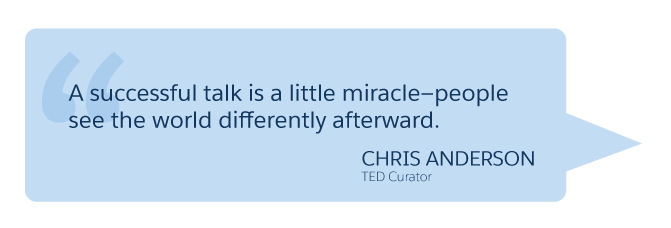
“A successful talk is a little miracle—people see the world differently afterward.” —Chris Anderson (TED Curator)
There are many paths to becoming a speaker at a Salesforce-related event. Some come to their first Salesforce event and dream of being on stage presenting their pearls of wisdom. Others find a topic they love so much, they can’t help but share it with everyone. Whatever your path, this module is for you!
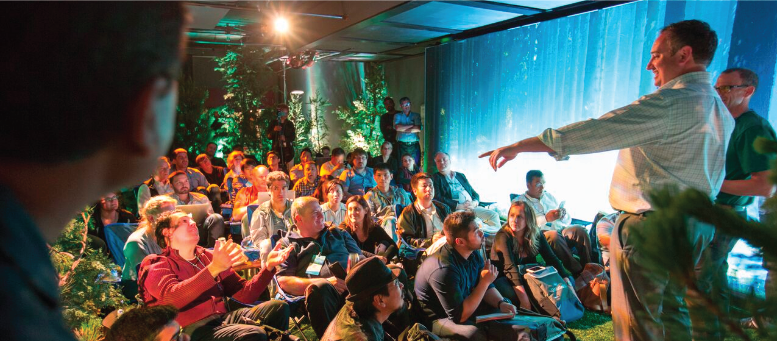
Throughout this module, we’ll follow Nyah Jackson, a force.com guru and Lightning Components developer, as she prepares to speak at a Salesforce event. She’ll create a stunning presentation and ultimately get a standing ovation, but only after careful preparation. Let’s join Nyah as she sets out to become a Salesforce speaker!
Good news for Nyah (and for all of you who want to present): there are many opportunities to speak at Salesforce-related events.
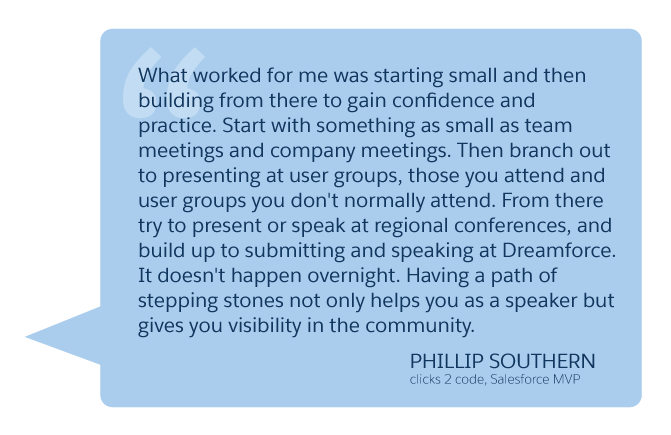
“What worked for me was starting small and then building from there to gain confidence and practice. Start with something as small as team meetings and company meetings. Then branch out to presenting at user groups, those you attend and user groups you don't normally attend. From there try to present or speak at regional conferences, and build up to submitting and speaking at Dreamforce. It doesn't happen overnight. Having a path of stepping stones not only helps you as a speaker but gives you visibility in the community.”—Phillip Southern (clicks 2 code, Salesforce MVP)
To start with, there are a slew of Salesforce community-sponsored events, like user groups and developer groups, and a growing number of community-run conferences, like Forcelandia, London’s Calling, Midwest Dreamin’, Southeast Dreamin’, and Tahoe Dreamin’.
There are also a number of official Salesforce events, like World Tours, and special audience and product-specific events like Connections (for digital marketers) and TrailheaDX (for Salesforce developers). And of course, there’s the big kahuna: Dreamforce.
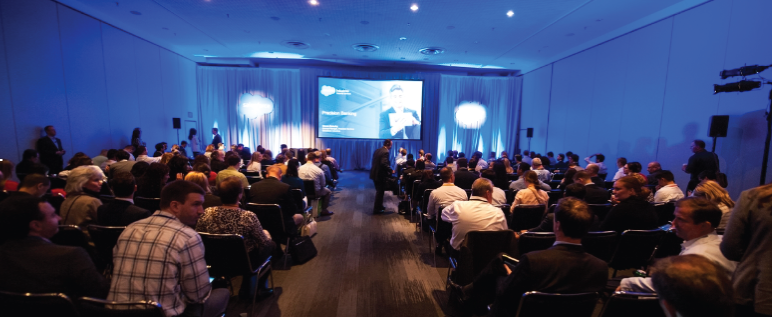
Some of these events are so large that they have multiple speaking tracks. Dreamforce, for example, has dedicated spaces for admins and developers, plus other areas focused on specific audiences like nonprofits, healthcare, and higher education. Each of these have different types of sessions, session lengths, and processes and deadlines for submission.
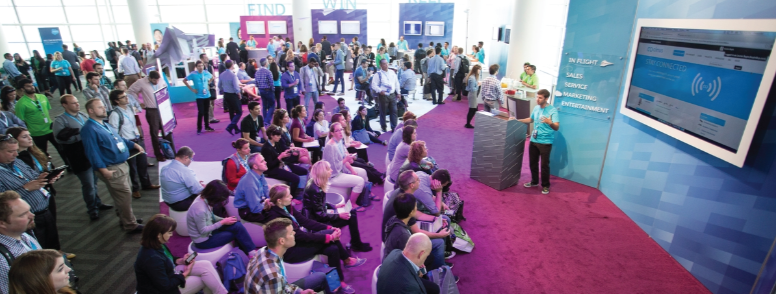
When you look for the right venue for your presentation, we recommend that you:
- Go local—If you're just getting started with public speaking, start attending your local user, developer, nonprofit, or Women in Tech group. You'll see Salesforce presentations regularly and learn about what topics resonate with an audience. Plus you'll learn a lot of new stuff.
- Start small—After you've become an active member of your local group, decide on a topic (more on that in a bit) and ask the organizer if you can present at an upcoming meeting.
- Take it on the road—Once you've presented at your local group, work your way up to a community-run conference, Salesforce World Tour stop, or Dreamforce.
After researching her options, Nyah decides to go for broke and sets her sights on a developer breakout session at Dreamforce.
Select a Topic
Nyah is super excited and can’t wait to dive in. She’s checked out the Dreamforce developer track call for submissions, read their tips for success (like many conferences, there is a list of topics they are hoping people submit), and looked at the requirements and deadlines.
If you speak about what you are passionate about, you both will walk away from your talk better for it, and that should always be the goal :-)”—Stephanie Herrera (NFP, Salesforce MVP)
Nyah sees that the organizers are specifically looking for content related to core platform technologies, including Lightning Components, so she feels good about her chances. She does some brainstorming and comes up with a list of four takes on this general topic.
- Tips for People New to Lightning Components
- Debugging Lightning Components
- Use Cases for Lightning Components
- Using Application Events with Lightning Components
These are awesome topics, but she only wants to submit a single idea—the one that will be the most fun to present and draw the biggest audience. She reaches out to her network on social media and on the success and developer communities, where she posts a poll to see what others think of these ideas. Turns out that not only is “Tips for People New to Lightning Components” the most popular idea, but her buddy Lek Bunyasarn is keen to present with her. Bonus!
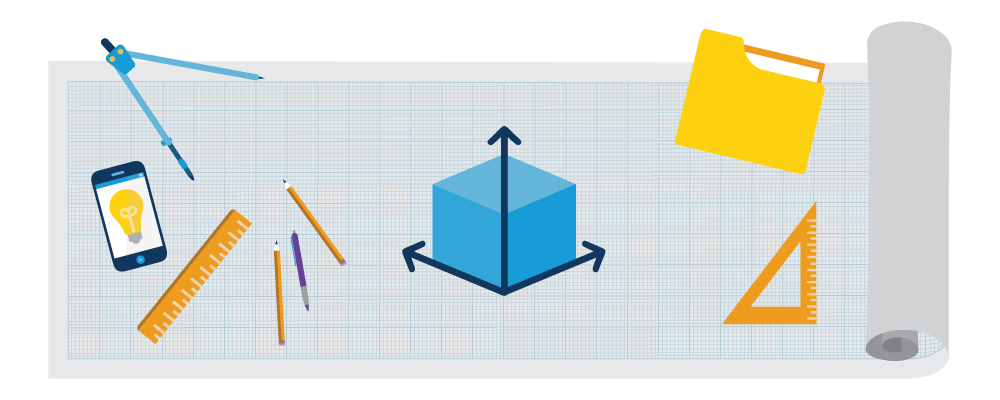
During this process, Nyah gets some feedback that the topic title is a little dull. Over a web conference, she and Lek brainstorm and come up with a new title, “Tips to Build Your First Lightning Component (for Smart People).”—Nyah and Lek are stoked about this title because:
- It’s catchy—everyone loves tips (and being called smart).
- It’s clear—the key phrases “Lightning Components” and “Build” are there so that people know immediately what the presentation is about (and can search for it).
- It’s concise—people will be able to remember the title and they’ll be able to use it in social media to promote the session (it’s only 63 characters long).
That’s truly a #winning combination.
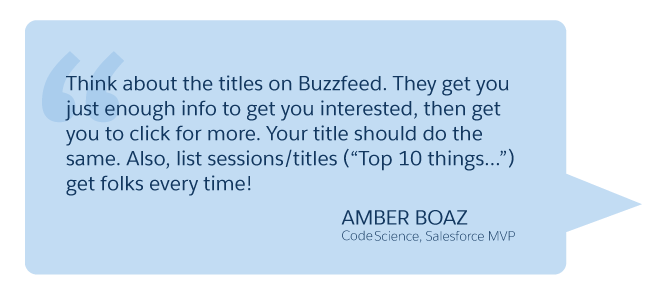
“Think about the titles on Buzzfeed. They get you just enough info to get you interested, then get you to click for more. Your title should do the same. Also, list sessions/titles (‘Top 10 things…’) get folks every time!”—Amber Boaz (CodeScience, Salesforce MVP)
Write an Abstract
Now that Nyah and Lek have their topic, it’s time to write an abstract. An abstract is a short description of what the session will be about. In a great abstract, the details shine and you tell your audience just what they’ll get out of the session. Because this is a technical session, Nyah and Lek will also let participants know if they should have a certain level of experience to get the most out of the session.
Follow this general process for writing a winning abstract.
- Define your audience.
- Define two or three learning objectives.
- Define your prerequisites.
- Write your abstract (and make it interesting).
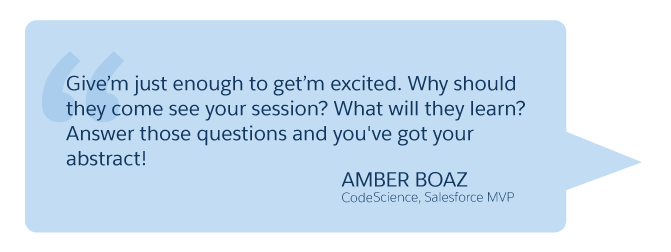
“Give'm just enough to get'm excited. Why should they come see your session? What will they learn?”—Amber Boaz (CodeScience, Salesforce MVP)
Define Your Audience
Whether you’re writing your abstract, building your slides, or coming up with your demo, it’s vital to keep your audience front and center. Ask yourself the following questions.
- Who is your primary audience?
- What is their skill level?
- What prior knowledge do they have?
- What matters to them?
- How do they best absorb information?
You may be tempted to have more than one primary audience. This is natural (we all want everyone to come to our presentations), but resist the urge. If you dilute your focus, then you dilute your impact. A single focus leads to a happy audience.
Pondering these questions, Nyah and Lek define their audience.
Our Audience:
Our primary audience is intermediate force.com developers. They likely know about Lightning Components, but haven’t done much (or any) development of them. They are familiar with Apex and with Visualforce. They’re looking to get a jump start and learn from people who have done a decent amount of Lightning Components development. They learn best by seeing live code demos and by having resources to refer back to when they get back to their office.
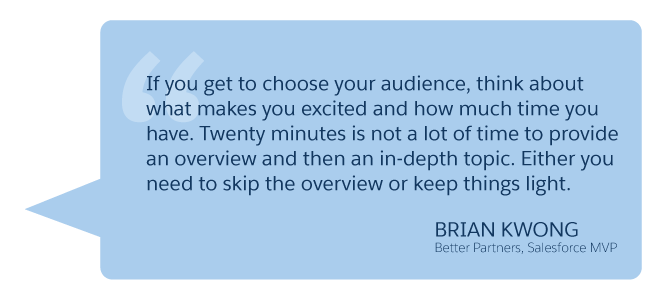
“If you get to choose your audience, think about what makes you excited and how much time you have. Twenty minutes is not a lot of time to provide an overview and then an in-depth topic. Either you need to skip the overview or keep things light.”—Brian Kwong (Better Partners, Salesforce MVP)
Define Your Learning Objectives
Having defined your audience, the first thing to do is nail down two to three learning objectives. Keeping it to just a few objectives ensures that your main message won’t be lost.
Begin by answering the question, “By the end of this presentation, what will attendees leave knowing?” Learning objectives start with a verb, and you generally want to stay away from generic verbs like “understand” and “learn.” See the resources section for more tips on writing learning objectives.
Over web conference, Nyah and Lek come up with the following learning objectives.
By the end of this presentation, attendees will be able to
- Explain the Lightning Components Framework.
- Describe some Lightning Component use cases.
- Apply tips for planning, developing, testing, and deploying Lightning Components.
Define Your Prerequisites
After defining your audience and learning objectives, deciding on prerequisites is the next important step. These will define what you need to cover in your presentation and what you can assume that your audience already knows.
The shorter your presentation duration, the more vital this step is, because you’ll have less time to get to the guts of your content. Your core audience wants to learn something new, not go over introductory information they may already know. As a general guideline, only spend 5–10% of your presentation time introducing your topic.
Use your abstract to clearly define your prerequisites. You don’t want anyone wishing they’d picked a different topic because the content was either too simple for them or over their head.
Nyah and Lek decide that their audience of intermediate developers should be familiar with what Lightning Components are. That way they can spend most of their time on their important tips.
Write Your Abstract
Once you have your audience, learning objectives, and prerequisites, your abstract will almost write itself. The trick is to put all that information into a small amount of space, and make it as compelling as possible to attract the right audience.
Nyah creates the following abstract.
Are you an intermediate developer wanting to create amazing Lightning Components? We can’t wait to help! We’ll give a very brief intro to Lightning Components and then get straight into showing actual use cases. We’ll share invaluable tips for all stages of development (planning, development, testing, and deployment). If you have a basic understanding of what Lightning Components are, but haven’t built any yet, this session is for you. Bring your burning questions and see if you can stump our experienced Lightning Components developers!
Nyah checks all the other session submission requirements and submits her application. Stay tuned for the next unit to see if their submission is accepted. #fingersCrossed